Laing is a traditional Filipino dish made from taro leaves. It’s a staple in Filipino cuisine, loved for its complex flavors. This dish is often served on special occasions, showing its cultural importance.
Laing highlights the versatility of taro leaves in cooking. The demand for exotic ingredients like Pandan, Lychee, and Taro is growing. This shows how much people love these flavors, making Laing a must-try for anyone interested in Filipino food.
Key Takeaways
- Laing is a traditional Filipino dish made from taro leaves, featuring a complex flavor profile that contributes to its popularity as a food.
- Taro leaves are a staple ingredient in Laing, showing their versatility in food preparation and their importance in Filipino cuisine.
- Laing is a significant component of Filipino cuisine, often served on special occasions and featuring a unique blend of flavors and ingredients.
- The dish is a reflection of the country’s rich culinary heritage, with its cultural significance extending beyond its delicious taste.
- Understanding the history and cultural significance of Laing can deepen one’s appreciation for this beloved dish and its main ingredient, taro leaves.
- Laing’s popularity may be attributed to its unique flavor profile, which is enhanced by the use of taro leaves, coconut milk, and chili peppers, making it a must-try food for anyone interested in exploring Filipino cuisine.
What is Laing?
Laing is a traditional Filipino dish from the Bicol region. It’s a comfort food loved by many. It’s also a big part of Bicolano culture, enjoyed at family gatherings and celebrations.
The main ingredients are taro leaves and coconut milk. These give Laing its rich and creamy taste. Meat or seafood, along with coconut milk, add flavor. Labuyo chili makes it spicy.
There are a few ways to make Laing, like:
- Inulukan, with river crabs
- Tinumok, a mix of seafood and spices
Laing is part of the ginataan style, cooked in coconut milk. It’s often served with boiled white rice. It’s also a side dish that goes well with meat or fish, called ulam.
The Role of Taro Leaves
Taro leaves are a key ingredient in Filipino cuisine. They are packed with vitamins A and C, and minerals like calcium and iron. This makes them a great choice for a healthy diet.
To prepare taro leaves, they are cooked in coconut milk. This adds flavor and reduces their natural bitterness. The result is a tasty and nutritious dish. Some interesting facts about taro leaves include:
- A 1-cup serving of cooked taro leaves provides 35 calories
- Taro leaves contain 6 grams of carbohydrates per 1-cup serving
- Each serving provides 4 grams of protein
- The fat content in a 1-cup serving is less than 1 gram
Taro leaves have a unique taste and soft texture. They are perfect for dishes like Laing. They are also great in soups and stews.

Nutritional Benefits of Taro Leaves
Taro leaves are full of nutrients. They are rich in vitamins A and C, and minerals like calcium and iron. They are a great addition to a balanced diet.
How Taro Leaves are Prepared
To prepare taro leaves, they are cooked in coconut milk. This reduces their bitterness and adds flavor. They are cooked for 20 to 30 minutes to get them tender.
Differences Between Taro and Other Greens
Taro leaves have a unique taste and soft texture. They are perfect for dishes like Laing. They are also great in soups and stews, adding nutrition to your meals.
Preparing Laing: A Step-by-Step Guide
To make Laing, a traditional Filipino dish, you need taro leaves, coconut milk, and spices. The recipe starts with picking fresh taro leaves and preparing coconut milk.
Laing needs a mix of spices for the perfect taste. Cooking the taro leaves in coconut milk makes them tender. For a spicy kick, add Thai chili peppers or other spicy items. Here’s how to do it:
- Start by sautéing the aromatics, such as garlic, onion, and ginger, in cooking oil.
- Add the coconut milk and bring to a simmer.
- Add the taro leaves and cook until they are tender.
- Season with spices and adjust the heat level to your liking.
By following these steps and using the right ingredients, you can make a tasty Laing dish. It’s perfect for those who love a spicy or mild flavor. Laing is a great choice for trying a new and exciting recipe.
Popular Variations of Laing
Laing is a traditional Filipino dish with many variations. One favorite is Laing with pork, which adds a rich flavor. For those who prefer veggies, Laing can be made with taro leaves and is just as tasty.
For a spicy twist, spicy Laing can include chili peppers or other spicy ingredients. The recipe can be adjusted to fit your taste.
Some popular Laing variations include:
- Laing with dried fish: This adds a salty, umami flavor.
- Laing with prawns: This adds a sweet, succulent flavor.
- Vegetarian Laing: Made with various veggies, like taro leaves, and is just as tasty.
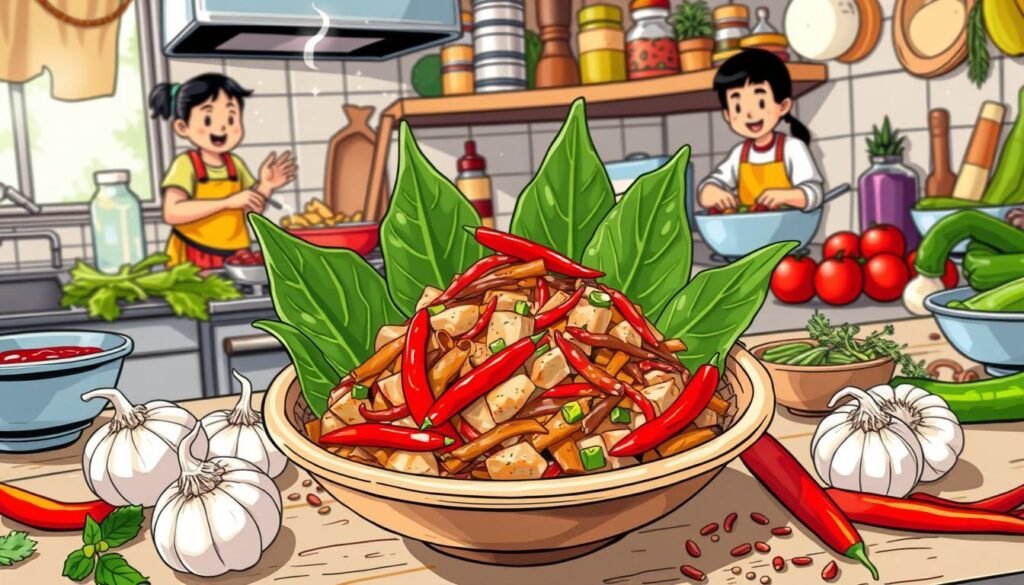
These Laing variations show the dish’s versatility. Whether you like a spicy or mild flavor, there’s a version for you.
| Variation | Ingredients | Cooking Time |
|---|---|---|
| Laing with Pork | Pork, taro leaves, coconut milk, garlic, onion, ginger | 30-45 minutes |
| Vegetarian Laing | Taro leaves, coconut milk, garlic, onion, ginger | 20-30 minutes |
| Laing with Prawns | Prawns, taro leaves, coconut milk, garlic, onion, ginger | 20-30 minutes |
Cooking Tips for Laing
To make perfect Laing, cook the taro leaves until they’re tender but firm. Simmer them in coconut milk for 40-50 minutes. Stir occasionally to avoid burning.
Adding spices like garlic, onion, and ginger boosts the flavor. Sauté these spices in oil before adding the taro leaves and coconut milk. This makes the dish rich and creamy.
Here are some extra tips for cooking Laing:
- Choose high-quality coconut milk for the best taste.
- Adjust the spice level by adding more or less chili peppers.
- Enjoy Laing with steamed rice or grilled fish for a complete meal.
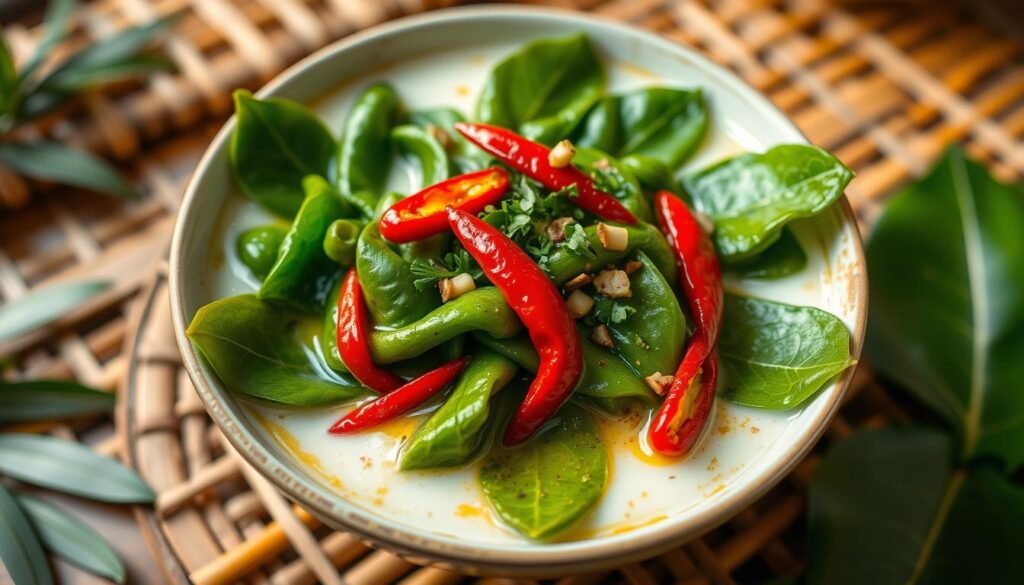
By using these tips, you can make a tasty and authentic Laing dish. The mix of taro leaves, coconut milk, and spices offers a rich and creamy taste experience.
| Ingredient | Quantity |
|---|---|
| Taro leaves | 3 cups |
| Coconut milk | 4 cups |
| Coconut cream | 1 cup |
The Health Benefits of Eating Laing
Eating Laing, a traditional Filipino dish, offers many health benefits. Taro leaves in Laing are packed with antioxidants. These help protect cells and lower disease risks. The dish also has dietary fiber from taro leaves and coconut milk. This fiber aids digestion and keeps you feeling full.
Some of the key health benefits of eating Laing include:
- High in antioxidants, which can help reduce the risk of certain diseases
- Rich in dietary fiber, which can aid in digestion and promote feelings of fullness
- Good source of essential vitamins and minerals, such as vitamin C and iron
Laing also offers emotional comfort and satisfaction. The taro leaves and coconut milk mix creates a creamy texture. This can be very soothing. Eating Laing is a great way to boost your health and enjoy a delicious Filipino dish.
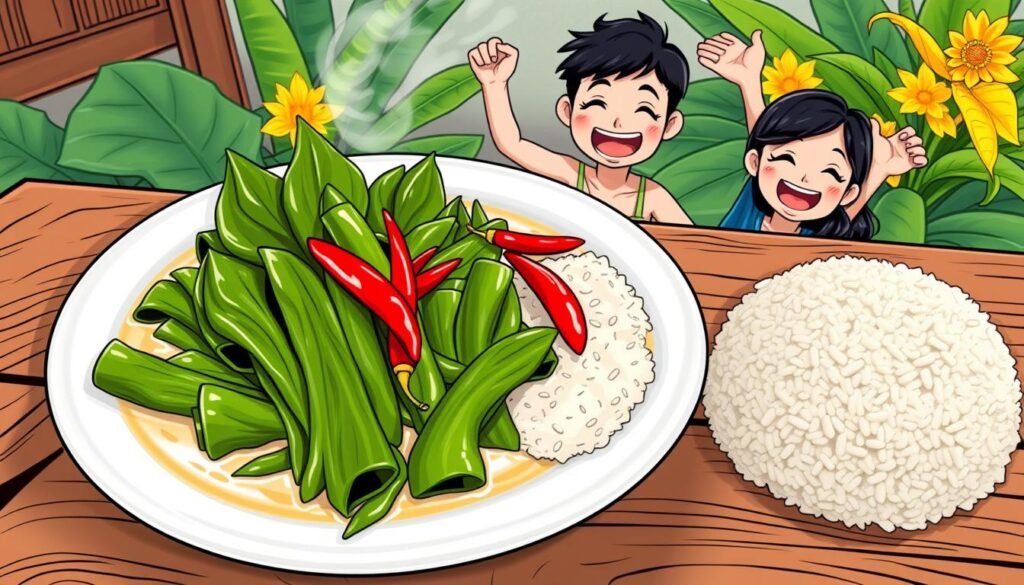
| Nutrient | Amount per cup |
|---|---|
| Calories | 35 |
| Carbohydrates | 6 grams |
| Protein | 4 grams |
| Fiber | 3 grams |
| Fat | less than 1 gram |
Laing in Modern Filipino Cuisine
Laing, a traditional Bicolano dish, has seen modern twists and flavors. This spicy dish is now a favorite in many Filipino restaurants. It comes in various recipe forms to please different palates. In modern Filipino cooking, Laing is often mixed with international ingredients or cooking styles.
Enjoying Laing in a spicy recipe with other Filipino dishes is popular. It pairs well with grilled pork or chicken. It’s also great as a topping for rice or noodles. The secret to a delicious Laing recipe is balancing the spicy taste with coconut milk and tender taro leaves.
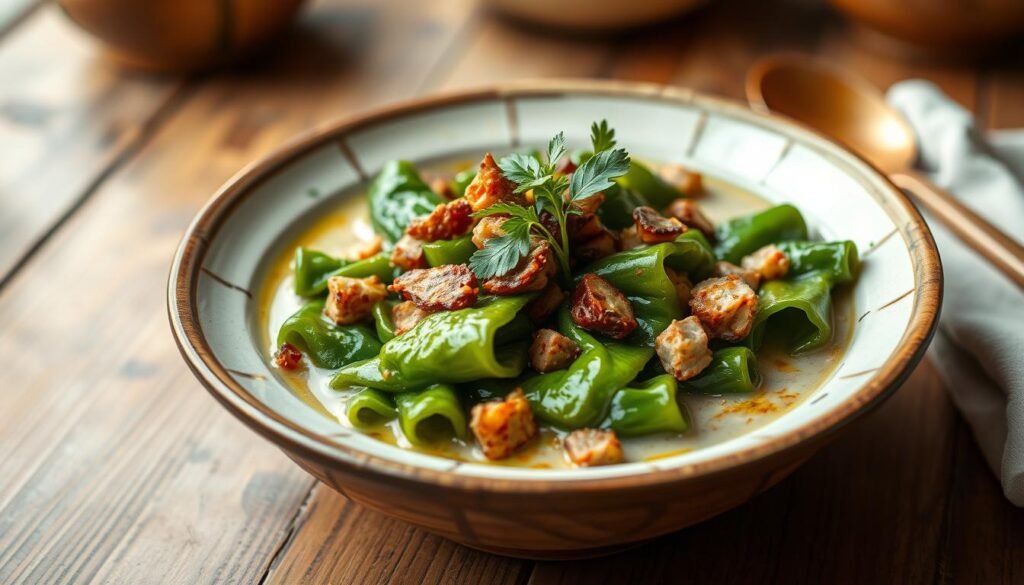
At Filipino gatherings, Laing is a hit alongside other traditional dishes. The spicy Laing is a favorite for those who like a kick in their food. To appeal to more people, many restaurants offer different recipe options. This includes vegetarian and vegan versions.
Some popular Laing variations include:
- Laing with pork or chicken
- Vegetarian Laing with tofu or tempeh
- Spicy Laing with extra chili peppers or spices
These variations show how Laing can fit different tastes and preferences.
Where to Find Laing in the Philippines
Laing, a traditional Filipino dish, is made with taro leaves. You can find it in many parts of the Philippines. The Bicol region is famous for its authentic Laing. To try the best Laing, visit restaurants that focus on Bicolano cuisine.
Regional Specialties of Laing
Laing varies by region in the Philippines. Here are some specialties:
- Laing with a spicy kick, commonly found in the Bicol region
- Laing with a creamy coconut milk sauce, popular in the southern regions
- Laing with a variety of protein sources, such as pork or shrimp, found in different parts of the country
Best Restaurants for Authentic Laing
For authentic Laing, check out these restaurants:
- Restaurant X, known for its traditional Bicolano cuisine
- Restaurant Y, offers a modern twist on Laing
- Restaurant Z, specializes in regional Filipino dishes, including Laing made with fresh taro leaves
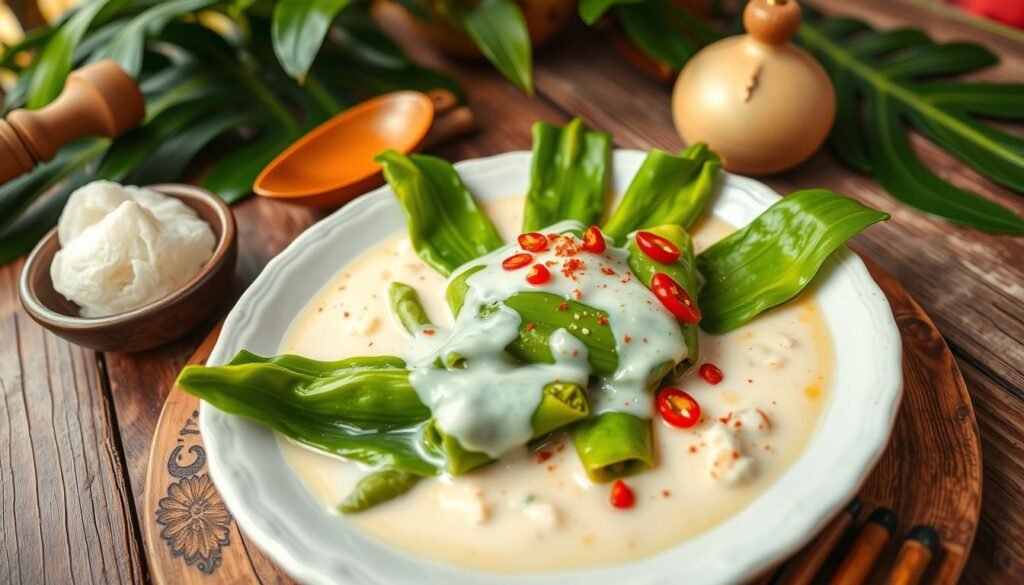
Laing: Traditional vs. Contemporary Variants
Laing, a traditional Filipino dish, has seen big changes in recent years. The old recipe used whole taro leaves, cubed pork or shrimp, and thick coconut milk. Now, chefs are adding new ingredients and cooking methods to Laing.
How Chefs are Reinventing Laing
Chefs are trying out different proteins like pork, shrimp, and dried fish. They’re also making regional versions of Laing, like Inulukan from Camalig, Albay, and Linapay or tinamuk from Aklan. These changes show how Filipino cuisine is always evolving while keeping its roots.
Preserving Traditional Recipes
It’s important to keep traditional recipes alive for Laing’s cultural heritage. The classic Laing mix has cubed pork, shrimp, or fish flakes, shrimp paste, and spices. Coconut milk adds healthy fats, which are good for energy and feeling full. By mixing old and new, Laing stays a favorite Filipino dish.

| Traditional Laing | Contemporary Laing |
|---|---|
| Whole fresh taro leaves | Shredded or whole taro leaves |
| Cubed pre-cooked pork or shrimp | Various proteins, such as pork, shrimp, and dried fish |
| Thick coconut milk | Coconut milk with other ingredients, such as spices and herbs |
Understanding Laing’s evolution helps us see the lively nature of Filipino cuisine. It shows the value of keeping traditional recipes alive while welcoming new ideas.
Pairing Laing with Beverages
Enjoying Laing is even better with the right drink. For those who love spicy food, a cool drink can soothe your taste buds. In the Philippines, many choose Filipino iced tea or fresh coconut water to go with Laing.
But, you can also try other food pairings. Some like to match Laing with buko juice (young coconut juice). It’s sweet and creamy, balancing the coconut milk’s richness and the dish’s spiciness.
Best Drinks to Complement Laing
- Fresh coconut water: a refreshing and light choice to pair with Laing
- Filipino iced tea: a sweet and creamy drink that complements the spiciness of Laing
- Buko juice (young coconut juice): a sweet and creamy drink that balances the richness of the coconut milk
Traditional Filipino Drinks with Laing
Traditional Filipino drinks like salabat (ginger tea) are great with Laing. They balance the dish’s flavors and make the meal more enjoyable. Whether you like something sweet and creamy or light and refreshing, there’s a drink for you to pair with Laing.
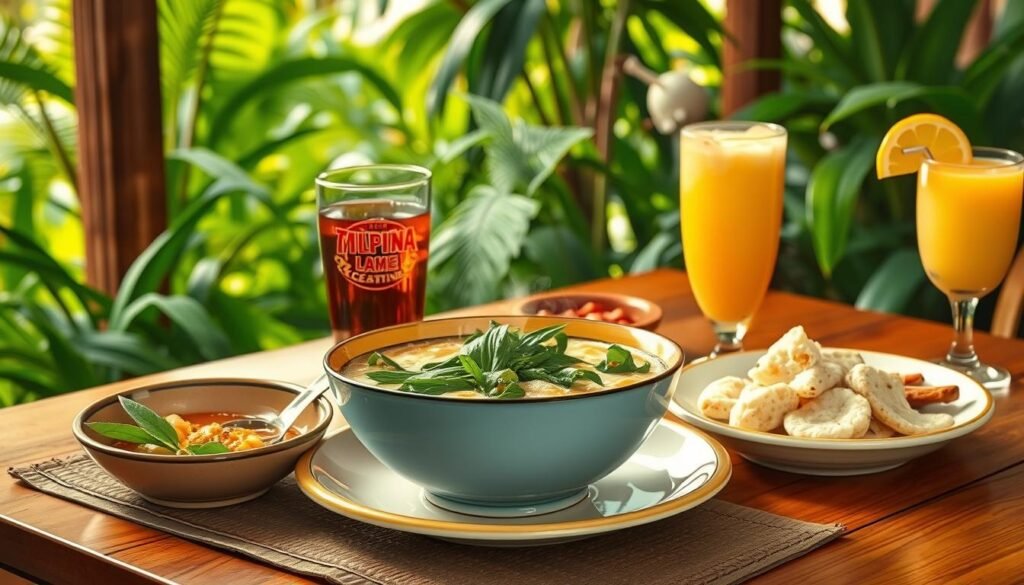
The Future of Laing in Global Cuisines
Laing, a dish from the Philippines, is becoming more famous around the world. Its unique taste comes from taro leaves. A traditional recipe uses taro leaves cooked in coconut milk, making it delicious and nutritious.
More people are interested in Filipino food because of its variety. With over 10 million Filipinos living abroad, their food is spreading. Laing and other Filipino dishes are now being tried by people everywhere, making them curious about the recipe and how to make it.
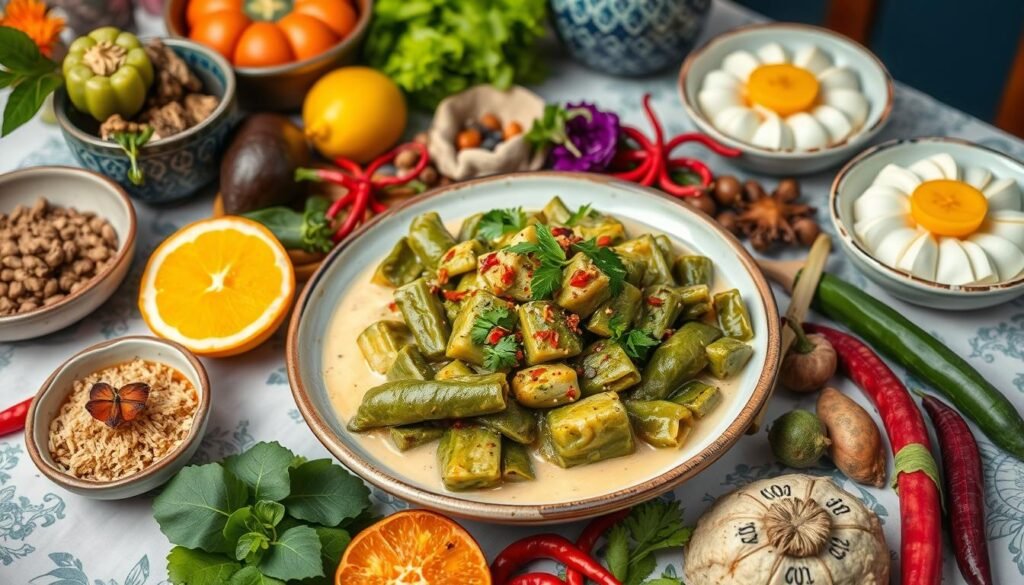
To keep Laing true to its roots, we must use the right ingredients and methods. This means using fresh or dried taro leaves, coconut milk, and spices. Following traditional recipe guidelines helps keep its cultural heritage and taste alive.
Laing’s popularity worldwide is opening doors for it in global cuisines. It can be made in new ways while staying true to its roots. With more people wanting to try Filipino food, Laing is set to become a favorite globally, sharing the unique taste of taro leaves and traditional Filipino recipe.
Sustainable Practices in Taro Leaf Farming
Taro leaf farming has an environmental impact that can be lessened with sustainable methods. Supporting local farmers who use organic farming or crop rotation helps. This approach not only keeps taro leaves available for food but also boosts the local economy.
In the Philippines, taro is a key crop, and sustainable farming is vital. Farmers can lessen their environmental impact by using natural fertilizers and reducing waste. This way, they can grow high-quality taro leaves for dishes like Laing, which often includes coconut milk.

- Using organic fertilizers to reduce chemical pollution
- Implementing crop rotation to maintain soil fertility
- Conserving water through efficient irrigation systems
By adopting these sustainable practices, taro leaf farmers help make our food system greener. They ensure taro leaves, a nutritious and versatile food crop, stay available for everyone.
Laing Recipes to Try at Home
Want to try Laing at home? Start with a classic recipe. It’s about cooking taro leaves in coconut milk with spices. For a spicy kick, add lemongrass or chili peppers.
Find a simple Laing recipe online. But, don’t be afraid to try new ingredients and cooking methods. This way, you can make Laing your own way.
Some must-haves for Laing are:
- Pork belly, cut into small pieces
- Taro leaves, dried or fresh
- Coconut milk
- Thai chilies, thinly sliced
- Ginger, peeled and thinly sliced
Here’s a basic Laing recipe:
| Ingredient | Quantity |
|---|---|
| Pork belly | ½ pound |
| Taro leaves | 1 ½ ounces |
| Coconut milk | 2 ½ cups |
| Thai chilies | 3-5 |
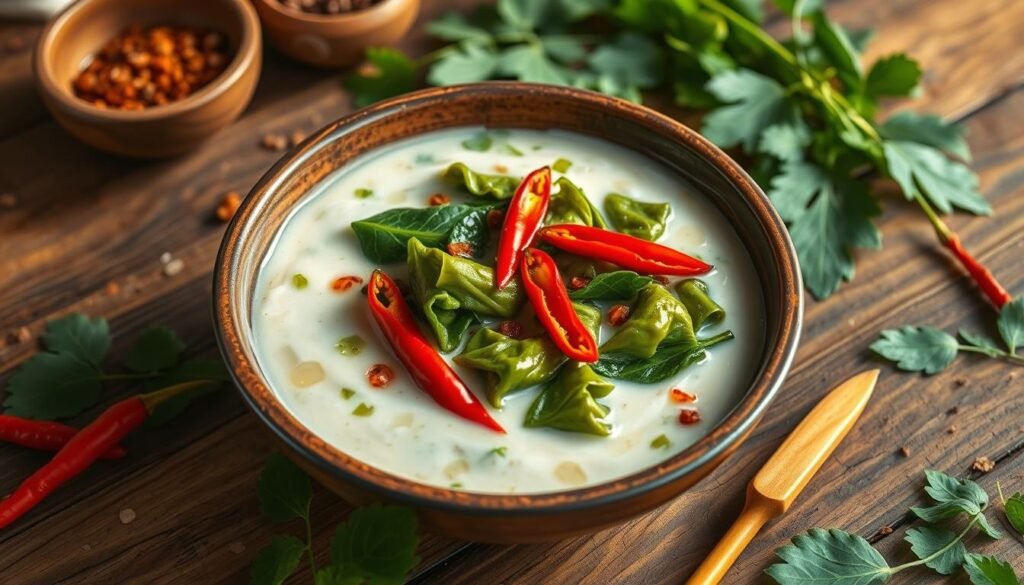
With these ingredients and a bit of practice, you can make your own tasty Laing. It’s sure to be spicy and delicious.
Community and Laing
Laing is more than a dish; it’s a symbol of community and hospitality in the Philippines. It brings people together, making it a favorite at local festivals and gatherings. In the context of community development, Laing plays a significant role in bringing people together and promoting a sense of belonging.
The social aspects of sharing Laing are deeply rooted in Filipino culture. It’s a dish that’s often served at special occasions, such as weddings and holidays. Sharing Laing shows respect and generosity to guests. Food has a way of bringing people together, and Laing is no exception.
Some popular festivals that celebrate Laing and other local dishes include:
- The Bicol Food Festival, which showcases the region’s unique cuisine, including Laing
- The Philippine Food Festival, which features a variety of dishes from different regions, including taro leaves-based recipes
- Local harvest festivals, which often include traditional dishes like Laing as part of the celebrations
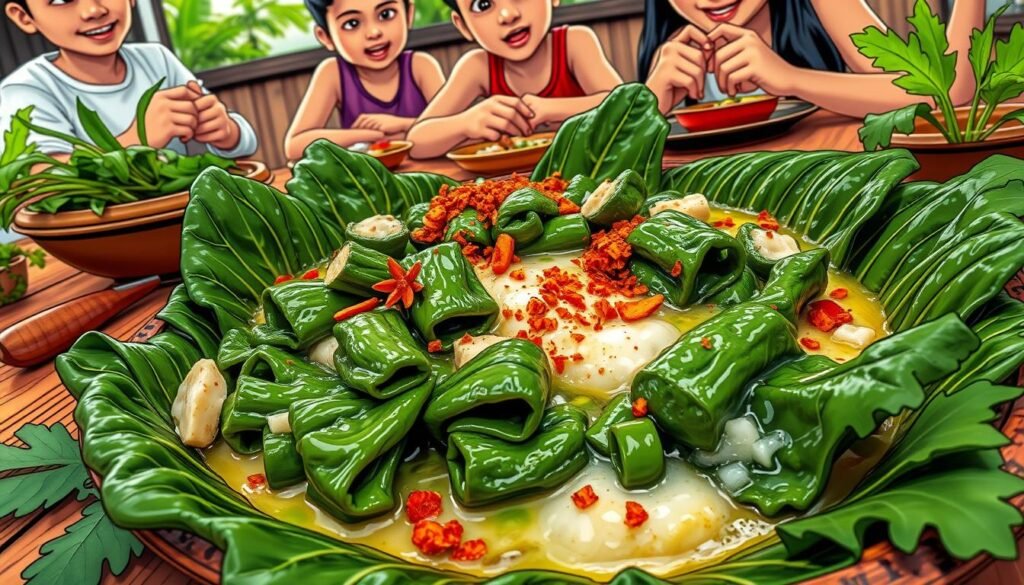
In conclusion, Laing is a dish that’s deeply rooted in Filipino culture and community. Its significance extends beyond the kitchen, representing hospitality, generosity, and social connection. Whether it’s served at a local festival or a family gathering, Laing is a dish that brings people together and fosters a sense of community.
Conclusion: The Importance of Laing
Laing is a culinary treasure from the Philippines, showing the nation’s rich culture and creative spirit. As we’ve seen in the previous sections, it’s not just a tasty dish. It also brings people together in Filipino communities.
Sharing Laing recipes, old or new, helps more people enjoy the Philippines’ flavors. It also helps us appreciate the country’s varied culinary traditions. By eating Laing, we support local farmers and keep the dish’s cultural value alive.
Laing’s importance goes beyond being a dish. It acts as a culinary ambassador, showing the world the lively and diverse Filipino cuisine. By embracing Laing and its many forms, we celebrate the Philippines’ rich food heritage. We also inspire a new wave of food lovers to dive into this amazing dish.
FAQ
What is Laing?
Laing is a traditional Filipino dish made from taro leaves. It’s known for its complex and delightful flavors. It’s a staple in Filipino cuisine, often served on special occasions.
What are the origins of Laing in Philippine cuisine?
Laing comes from the Bicol region of the Philippines. It’s a comfort food there. It’s a staple in Bicolano cuisine and holds cultural significance, often served during family gatherings and celebrations.
What are the common ingredients used in Laing?
Laing uses taro leaves, coconut milk, and various spices. These ingredients contribute to its unique flavor.
What are the nutritional benefits of taro leaves?
Taro leaves are rich in nutrients like vitamins A and C, and minerals like calcium and iron. They’re cooked in coconut milk to reduce their natural bitterness.
How do you prepare Laing?
Preparing Laing starts with selecting fresh taro leaves and preparing coconut milk. It requires a balance of spices and cooking techniques like simmering the leaves in coconut milk to tenderize the taro.
What are the common mistakes to avoid when cooking Laing?
Avoid overcooking the leaves, which can make them too soft. Also, don’t forget to balance the spices, as too much can make the dish too spicy or too bland.
What are the popular variations of Laing?
Laing can be made in several ways. Versions with pork add a rich, savory flavor. Vegetarian options focus on the taro leaves’ natural taste. Spicy Laing innovatives can include chili peppers or other spicy ingredients for an extra kick.
How do you achieve the right consistency in Laing?
To get the right consistency, cook the taro leaves until they’re tender but firm. Adding spices like garlic, onion, and ginger can enhance the flavors.
What are the health benefits of eating Laing?
Laing is not just delicious but also offers health benefits. Taro leaves are rich in antioxidants. The dietary fiber in Laing aids digestion and promotes feelings of fullness. It’s a comfort food that provides emotional comfort and satisfaction.
Where can I find authentic Laing in the Philippines?
Authentic Laing can be found in various regions of the Philippines, with the Bicol region being the most renowned. Restaurants specializing in Bicolano cuisine often serve Laing as one of their signature dishes.
How are traditional Laing recipes being reinvented in modern Filipino cuisine?
Contemporary chefs are reinventing Laing by adding new ingredients and cooking techniques. This reflects the dynamic nature of Filipino cuisine. But, it’s important to preserve traditional recipes to maintain Laing’s cultural heritage.
What are the best beverages to pair with Laing?
Drinks like Filipino iced tea or fresh coconut water can cool down the palate. Traditional Filipino drinks, such as buko juice or salabat, can balance the richness of the coconut milk and the spiciness of the dish.
What are the challenges in maintaining the authenticity of Laing as it gains global popularity?
As Filipino cuisine gains popularity worldwide, it’s important to ensure Laing is made with traditional ingredients and cooking methods. This helps preserve its cultural heritage and unique flavor profile.
How can we support sustainable taro leaf farming?
Supporting local farmers who use sustainable methods, like organic farming or crop rotation, can help reduce the environmental footprint of taro cultivation. This ensures the long-term availability of taro leaves for Laing and other dishes.
What are some Laing recipes to try at home?
Start with a classic recipe using taro leaves, coconut milk, and spices. For a tropical twist, add lemongrass or chili peppers to give the dish a unique flavor.
How is Laing connected to community and social gatherings in the Philippines?
Laing is often at the center of community gatherings and festivals in the Philippines, mainly in the Bicol region. It symbolizes hospitality and community bonding. Its preparation and sharing foster social connections among family and friends.
Source Links
- A Journey Through Asia: Decoding the Flavors of Pandan, Lychee, and Taro – https://foodfluff.com/a-journey-through-asia-decoding-the-flavors-of-pandan-lychee-and-taro
- Filipino Cuisine: Must-Try Dishes for New Arrivals – https://pinaywise.com/articles/filipino-cuisine-must-try-dishes-for-new-arrivals/?srsltid=AfmBOoocQR9UpeLpVNmMZSabQunZFVjCHTNg_AgMPr6oQuAJddDvqbCA
- Laing (food) – https://en.wikipedia.org/wiki/Laing_(food)
- Laing – https://www.kawalingpinoy.com/laing/
- Panlasang Pinoy Laing Recipe – https://panlasangpinoy.com/laing-recipe/
- Taro Leaves: Nutrition, Benefits, and Uses – https://www.healthline.com/nutrition/taro-leaves
- Laing na Gabi – https://panlasangpinoy.com/laing-na-gabi-recipe/
- how to make laing recipe – https://www.niceys.ca/post/how-to-make-laing-recipe
- Laing Recipe – ASTIG Vegan – https://www.astigvegan.com/laing-recipe/
- Laing – Two Variations – Market Manila – https://www.marketmanila.com/archives/laing-two-variations
- One of Our Family’s Favorite Vegetable Dish – Laing – https://thekitcheninvader.wordpress.com/2013/10/09/laing/
- Fiery And FLavorful Dish: "Laing na Gata" – https://hive.blog/@teacherlynlyn/fiery-and-flavorful-dish-laing-na-gata
- Spicy Laing Recipe – https://panlasangpinoy.com/spicy-laing-recipe/
- Easy Laing Recipe (Taro in Coconut Milk) | Amiable Foods – https://amiablefoods.com/laing-recipe/
- What Are the Benefits of Taro Leaves, and Are There Side Effects? – https://www.medicinenet.com/what_are_the_benefits_of_taro_leaves_side_effects/article.htm
- 7 Surprising Benefits of Taro Root – https://www.healthline.com/nutrition/taro-root-benefits
- Health Benefits of Taro Leaves — thecoconet.tv – The world’s largest hub of Pacific Island content.uu – https://www.thecoconet.tv/coco-talanoa/health-well-being/health-benefits-of-taro-leaves/
- Mesa Filipino Moderne – https://amcarmenskitchen.com/2015/04/26/mesa-filipino-moderne/
- Authentic Laing Recipe (Taro leaves in Coconut Milk) – Foxy Folksy – https://www.foxyfolksy.com/authentic-laing-recipe-taro-leaves-coconut-milk/
- Laing – https://www.pacificbay.com.ph/products/laing?srsltid=AfmBOooETVQE9oR85eJ6L84b4GVfREU-9u_hH5DetwkGmksbJPXx8JVg
- Laing (food) – Wikiwand – https://www.wikiwand.com/en/articles/Laing_(food)
- What Is the History Behind Laing Na Gabi? – pinascuisine.com – https://pinascuisine.com/what-is-the-history-behind-laing-na-gabi/
- Laing (using Haddock and Collard Greens) – https://kusinanimanang.blogspot.com/2009/04/laing-using-haddock-and-collard-greens.html
- Laing Recipe: How I Fell in Love with this Mushy and Creamy Dish – – https://kusinaniteds.com/2020/04/laing-recipe-how-i-fell-in-love-with-this-mushy-and-creamy-dish.html
- Laing (Dried Taro Leaves with Coconut) – https://asliceofkatecom.wordpress.com/2019/01/29/laing-dried-taro-leaves-with-coconut/
- Filipino Cuisine: A Rich Tapestry Of Culinary Traditions – https://www.eliteplusmagazine.com/Article/950/Filipino_Cuisine__A_Rich_Tapestry_Of_Culinary_Traditions
- PDF – https://w3.cbsua.edu.ph/wp-content/uploads/2021/07/8_ACRIJ_Vol1No1_Morphological_Characterization_of_Taro.pdf
- PNS-BAFPS 37-2006-Taro Leaves.doc – http://spsissuances.da.gov.ph/attachments/article/1103/PNS-BAFS37-2006-TaroLeaves.pdf
- Taro Leaves – https://specialtyproduce.com/produce/Taro_Leaves_3409.php
- Ginataang Laing Recipe | Mikha Eats – https://mikhaeats.com/filipino-laing/
- Super Easy Laing – – https://myjoydelights.com/super-easy-laing/
- For society – https://www.laingorourke.com/company/sustainability/social-value/
- Community and Belonging curated by Christopher Laing — Open City – https://open-city.org.uk/blog/community-and-belonging-curated-by-christopher-laing
- The Philadelphia Association | history – https://www.philadelphia-association.org.uk/history
- Freud, Sartre, Laing: Power And Authenticity – https://www.tutorhunt.com/resource/4117/
- Answers to: Write an essay about Laing dam – https://www.classace.io/answers/write-an-essay-about-laing-dam

